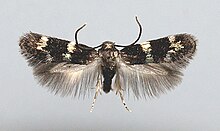Elachista gleichenella
| Elachista gleichenella | |
|---|---|

| |
| Female | |

| |
| Male | |
| Scientific classification | |
| Domain: | Eukaryota |
| Kingdom: | Animalia |
| Phylum: | Arthropoda |
| Class: | Insecta |
| Order: | Lepidoptera |
| Family: | Elachistidae |
| Genus: | Elachista |
| Species: | E. gleichenella
|
| Binomial name | |
| Elachista gleichenella | |
| Synonyms | |
|
List
| |
Elachista gleichenella is a moth of the family Elachistidae found in most of Europe.
Description[edit]
The wingspan is 8–9 mm (0.31–0.35 in).The head is bronzy -metallic.Forewings are dark bronzy -fuscous ; a small basal spot, a fascia before middle, and an outwards -angulated fascia towards apex pale golden-metallic. Hindwings are grey.The Larva is whitish, faintly purple-tinged ; head dark brown ; 2 with two purple-blackish marks.[2]
Biology[edit]
The larvae feed on Carex curvula, Carex digitata, Carex divulsa, star sedge (Carex echinata), glaucous sedge (Carex flacca), dwarf sedge (Carex humilis), smooth-stalked sedge (Carex laevigata), soft-leaved sedge (Carex montana), Carex morrowii, Carex muricata, Carex ornithopoda, false fox-sedge (Carex otrubae), greater tussock-sedge (Carex paniculata), pendulous sedge (Carex pendula), Carex pilosa, Carex sempervirens, wood sedge {Carex sylvatica}, Carex umbrosa, tufted hairgrass (Deschampsia cespitosa), white wood-rush (Luzula luzuloides), hairy wood-rush (Luzula pilosa), Luzula plumose and greater wood-rush (Luzula sylvatica). Young larvae form a narrow meandering corridor, which gradually widens to nearly the full width of the leaf. The larvae make a new mine in early winter most of the time. This mine is brown and situated close to (or within) the red coloured dying apical part of the leaf. Pupation takes place outside of the mine.[3]
Distribution[edit]
The moth is found in most of Europe (except the Iberian Peninsula), east into northern Russia.[4]
References[edit]
- ^ "Elachista (Elachista) gleichenella (Fabricius, 1781)". Fauna Europaea. Retrieved 9 March 2020.
- ^ Meyrick, E., 1895 A Handbook of British Lepidoptera MacMillan, London pdf
 This article incorporates text from this source, which is in the public domain. Keys and description
This article incorporates text from this source, which is in the public domain. Keys and description
- ^ "Elachista gleichenella (Fabricius, 1781)". Bladmineerders.nl. Archived from the original on July 23, 2011. Retrieved March 7, 2010.
- ^ Ellis, W N. "Elachista gleichenella (Fabricius, 1781) twin-barred dwarf". Plant Parasites of Europe. Retrieved 9 March 2020.
External links[edit]
